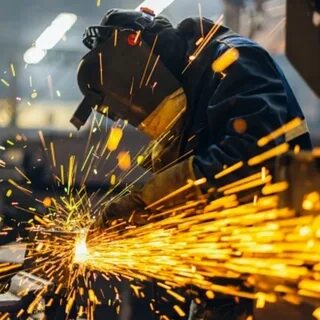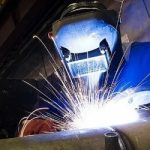Steel fabrication stands tall as one of the fundamental pillars in the world of construction. Its significance in erecting towering structures and robust infrastructures, undertaken by a dedicated steel fabrication company, cannot be overstated. From the skeletons of towering skyscrapers to the framework of bridges spanning mighty rivers, fabrication plays a pivotal role in shaping the landscapes of our cities and nations. The expertise and precision brought forth by a proficient steel fabrication company are integral in translating architectural blueprints into tangible marvels that define modern civilization’s skyline and connectivity.
What is Steel Fabrication?
At its core, steel fabrication involves the transformation of raw steel into various shapes and structures through cutting, bending, and assembling. This process results in the creation of components used in construction, such as beams, columns, trusses, and frameworks. The versatility of steel allows for intricate designs and the capability to withstand immense pressures and forces, making it an indispensable material in the construction industry.
The Backbone of Skyscrapers and Buildings
Think of the iconic skyscrapers that pierce the sky. Steel fabrication is their hidden strength. The steel framework of these buildings not only provides structural support but also enables architects to design awe-inspiring structures that capture the imagination. The flexibility and strength of steel allow for the creation of vast open spaces within buildings, maximizing functionality and aesthetics simultaneously.
Bridges: Engineering Marvels
Bridges, these engineering marvels, serve as vital connections between distant locations. Their durability and resilience, attributes owed largely to steel fabrication, guarantee safe passage across varying terrains and expanses. Steel’s remarkable capacity to endure both tension and compression renders it the prime selection for crafting bridges in diverse forms and sizes.
Whether crafting a majestic suspension bridge spanning great distances or a sturdy beam bridge traversing over rivers, the reliability of steel remains unwavering. Its ability to withstand immense pressures ensures the secure transit of vehicles and pedestrians, instilling confidence in the structural integrity of these lifelines. Steel’s role in ensuring safe passage across these architectural wonders signifies its crucial importance in bridging geographical gaps and fostering connectivity.
Infrastructure: Beyond Buildings and Bridges
Steel fabrication extends its prowess beyond traditional constructions like buildings and bridges. Its influence spans across diverse infrastructural projects, weaving a resilient network across roads, tunnels, and railways. The durability of steel proves indispensable in ensuring the longevity of these critical arteries of transportation, resisting the wear and tear inflicted by heavy traffic and environmental elements. In ensuring this durability, collaborations with reputable fabrication companies become pivotal, providing the expertise and materials essential for constructing infrastructure capable of withstanding the rigors of constant use and environmental challenges.
Moreover, the realm of renewable energy structures benefits immensely from steel fabrication. Wind turbines, solar panel supports, and hydroelectric plants all rely on the robustness of steel. Its ability to endure harsh conditions while maintaining structural integrity positions it as a prime choice for sustainable infrastructure, reinforcing the backbone of a greener future. Steel’s adaptability and strength play a pivotal role in fortifying these vital elements that underpin the functionality and sustainability of our modern world.
Advantages of Steel Fabrication
The use of steel fabrication in construction boasts numerous advantages. Firstly, its remarkable high strength-to-weight ratio significantly reduces the overall weight of structures compared to conventional materials. This characteristic not only facilitates easier handling during construction but also minimizes transportation costs. Furthermore, the lighter weight translates to reduced foundation requirements, allowing for cost and time savings during the building process.
Another compelling advantage lies in steel’s recyclability, marking it as an environmentally conscious choice in construction. In today’s era of heightened environmental awareness, the ability to recycle steel aligns seamlessly with sustainable construction practices. By opting for fabrication, builders contribute to a circular economy, reducing waste and conserving resources while meeting the demands for durable and robust construction materials. The eco-friendly nature of steel further solidifies its position as a preferred choice in modern construction methodologies.
Innovations in Steel Fabrication
The advancements in steel fabrication techniques are propelled by technology. Specifically, Computer-Aided Design (CAD) and Computer-Aided Manufacturing (CAM) tools have revolutionized the process. CAD aids in intricate design, while CAM ensures accurate translation to physical components. This collaboration streamlines production, reducing errors and time. Additionally, metallurgical developments have birthed stronger steel alloys. These alloys promise enhanced durability and resilience. They expand design possibilities, offering safer and more visually captivating structures. The synergy of technology and metallurgy reshapes construction, fostering innovation and reliability in steel fabrication.
Conclusion
Steel fabrication remains at the core of construction, serving as an irreplaceable foundation in the modern world. Its adaptability, coupled with unrivaled strength, propels the evolution of architectural marvels and engineering feats. Without a doubt, steel fabrication stands as the bedrock upon which towering skyscrapers, intricate bridges, and robust infrastructures emerge, shaping the world we live in today. As technology advances, ushering in new innovations, steel fabrication’s significance only amplifies, ensuring its enduring presence as an integral component in constructing the landscapes of tomorrow. In this pursuit, collaboration with reputable steel fabrication companies becomes pivotal, harnessing expertise and cutting-edge techniques to sculpt the future of construction seamlessly.
Moreover, the relentless advancements in steel fabrication techniques continue to redefine the boundaries of construction. With each stride in technology, steel fabrication evolves, offering more refined capabilities and pushing the envelope of what’s achievable. Its role as a cornerstone in construction remains unwavering, promising to sculpt the future with structures that surpass current imagination. The trajectory of steel fabrication is not merely about today’s construction but also about the endless possibilities and transformative potential it holds for the landscapes of the future.
Also explore: Architects of Innovation: Redefining Boundaries with Steel Fabrication




